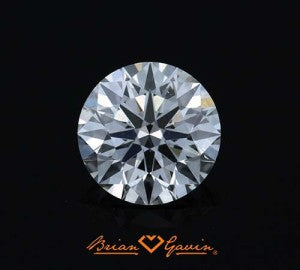
Do diamond inclusions affect diamonds brilliance?
“I’m shopping for a diamond engagement ring and want to get the largest diamond possible for my budget of ± 7k, and am thinking of this 1.01 carat, H-color, SI-2 clarity, Brian Gavin Signature round diamond, but I’m wondering whether the inclusions affect the diamonds brilliance. The reason I ask is because I’m able to see the inclusions pretty easily in the clarity photograph and video, so are they interrupting the light return of the stone or anything like that? Should I only look for diamonds that don’t have any inclusions underneath the table facet, or is it not going to matter? I don’t want there to be any dead spots in the diamond."
The effect diamond inclusions have on diamond brilliance:
 I’m going to assume that your question pertains to the potential effect that the inclusions within a diamond can have upon the overall light return and visual performance of a diamond, in terms of whether or not they interfere with the sparkle factor of the diamond… the inclusions within a diamond would have to be pretty substantial for them to have any measurable effect upon the visible brightness or sparkle factor, however I have seen it on rare occasions.
I’m going to assume that your question pertains to the potential effect that the inclusions within a diamond can have upon the overall light return and visual performance of a diamond, in terms of whether or not they interfere with the sparkle factor of the diamond… the inclusions within a diamond would have to be pretty substantial for them to have any measurable effect upon the visible brightness or sparkle factor, however I have seen it on rare occasions.
First of all, rest assured that Brian Gavin personally evaluates every diamond selected for the Brian Gavin Signature and Brian Gavin Blue collections of super ideal cut diamonds, and that any diamond which does not meet his selection criteria for overall diamond cut quality, proportions, and visual performance is rejected.
The inclusions within the 1.01 carat, H-color, SI-2 clarity, Brian Gavin Signature round diamond that you are considering, are quite small and are not impeding the light return of the diamond to the degree which it might be detected using the naked eye, the inclusions consist primarily of small feathers which are located off to the edge of the diamond, and small diamond crystals, and clusters of pinpoint size diamond crystals known as clouds.
Diamond inclusion type clouds explained:
I imagine that the word “clouds” might have thrown you for a loop, because people often equate this inclusion type to being similar to clouds up in the sky, thus they might be capable of blocking out the light; however the size of the cloud would have to be pretty substantial for this to have a measurable effect upon the visual performance of the diamond; and Brian Gavin would have rejected the diamond if that were the case, these will be barely visible through a loupe.
Diamond crystals and clouds are actually one of my favorite inclusions types, because they are essentially just tiny diamonds that were trapped within the larger diamond crystal as it formed, I’ve always thought that clouds of pinpoint size diamond crystals look a lot like constellations of stars up in the sky, they sparkle and twinkle just like stars when viewed through a diamond grading loupe.
In this particular instance, the pinpoint size diamond crystals that comprise the clouds within this diamond are located in clusters that resemble straight lines within the diamond, they are minute in size, and are translucent in appearance, they are too small to have any measurable effect upon the light return of the diamond. The clouds you should be concerned about are those which cover large areas of the diamond, such as those which cover one quarter to one third of a quadrant at a time.




















